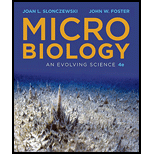
Concept explainers
To review:
The bacterial cell asymmetry that leads to different structural and functional features of daughter cells and also mention the significance of asymmetry in environmental adaptation and antibiotic therapy.
Introduction:
Cell division is one of the major processes that give rise to copies of the original cell into two or many daughter cells. Through this process, the genetic material is separated into daughter cells in the same amount. The daughter cell consists of the same number of similar chromosomes.
Asymmetric cell division gives rise to two daughter cells and the cellular fate of these daughter cells may vary from one another. Asymmetric cell division indicates intrinsic asymmetric divisions. During this cell division, the stem cell generates one stem cell and one differentiated cell. The daughter cells in asymmetric division receive unequal number of genes during cell division of the mother cell.
Asymmetric cell division gives rise to cellular diversity and regulates the homeostasis of adult tissues. It alters dynamic cell behavior in response to the environmental changes. It leads into the genotypic selection that does not possess heritable allelic changes but consist of a temporary state which is compatible with the altered environment.
The alternator and the accelerator are the two classes of cells that are obtained from the asymmetrical division of the mycobacterial cell. Both of these cells reflect tolerance to different types of antibiotics. This is achieved due to the inheritance of distinct genes for the antibiotic resistance from the stem cell. One cell behaves like a stem and the other reflects a separate behavior.
Want to see the full answer?
Check out a sample textbook solution
Chapter 3 Solutions
Microbiology: An Evolving Science (Fourth Edition)
- 22. Which of the following mutant proteins is expected to have a dominant negative effect when over- expressed in normal cells? a. mutant PI3-kinase that lacks the SH2 domain but retains the kinase function b. mutant Grb2 protein that cannot bind to RTK c. mutant RTK that lacks the extracellular domain d. mutant PDK that has the PH domain but lost the kinase function e. all of the abovearrow_forwardWhat is the label ?arrow_forwardCan you described the image? Can you explain the question as well their answer and how to get to an answer to an problem like this?arrow_forward
- Describe the principle of homeostasis.arrow_forwardExplain how the hormones of the glands listed below travel around the body to target organs and tissues : Pituitary gland Hypothalamus Thyroid Parathyroid Adrenal Pineal Pancreas(islets of langerhans) Gonads (testes and ovaries) Placentaarrow_forwardWhat are the functions of the hormones produced in the glands listed below: Pituitary gland Hypothalamus Thyroid Parathyroid Adrenal Pineal Pancreas(islets of langerhans) Gonads (testes and ovaries) Placentaarrow_forward
 Biology (MindTap Course List)BiologyISBN:9781337392938Author:Eldra Solomon, Charles Martin, Diana W. Martin, Linda R. BergPublisher:Cengage Learning
Biology (MindTap Course List)BiologyISBN:9781337392938Author:Eldra Solomon, Charles Martin, Diana W. Martin, Linda R. BergPublisher:Cengage Learning Biology 2eBiologyISBN:9781947172517Author:Matthew Douglas, Jung Choi, Mary Ann ClarkPublisher:OpenStax
Biology 2eBiologyISBN:9781947172517Author:Matthew Douglas, Jung Choi, Mary Ann ClarkPublisher:OpenStax Principles Of Radiographic Imaging: An Art And A ...Health & NutritionISBN:9781337711067Author:Richard R. Carlton, Arlene M. Adler, Vesna BalacPublisher:Cengage Learning
Principles Of Radiographic Imaging: An Art And A ...Health & NutritionISBN:9781337711067Author:Richard R. Carlton, Arlene M. Adler, Vesna BalacPublisher:Cengage Learning- Surgical Tech For Surgical Tech Pos CareHealth & NutritionISBN:9781337648868Author:AssociationPublisher:Cengage





